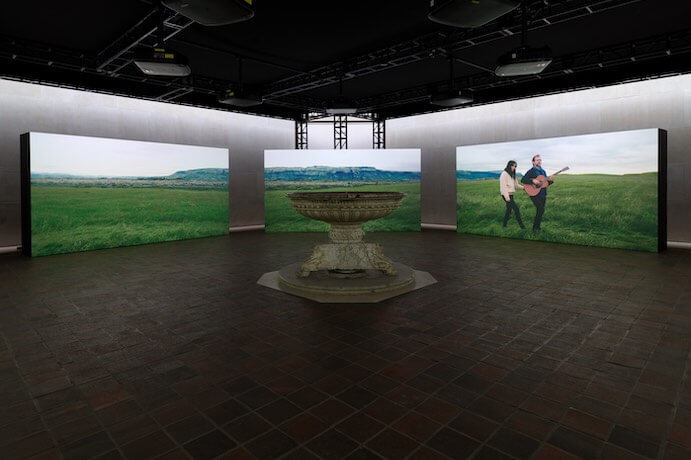Death Is Elsewhere (2019) is a seven-channel video installation that captures a single song performed endlessly, without beginning or end. Filmed in one shot on a hill in southern Iceland, the sky is light but it’s midnight, and it looks cold but it’s midsummer. It’s in this not-right space that the musicians—Gyða and Kristín Anna Valtýsdóttir, and Aaron and Bryce Dessner of the National—sing, strum and walk through the screens as two pairs of male/female twins. This is all they do for 77 minutes, but viewers at the Met (the museum this time, not the opera house) are transfixed.
Death Is Elsewhere, which was on view at the Metropolitan Museum of Art this summer, is the latest work of endurance art by Ragnar Kjartansson The acclaimed Icelandic artist interrogates the production of feeling, using musical composition as his medium. He twists and stretches one morose lyric (culled from various poetry books laying around his house), or one song of sorrow, into a humorous release. Say ‘sad’ over and over, for hours on end, and there’s nothing sad about it.
In 2007, Ragnar sang the words “Sorrow conquers happiness” hundreds of times, always the same eight-bar minor-key melody. But the orchestra behind him alters the performance slowly and slightly. “The musicians’ quite ordinary acts become suffused with suspense,” James Gibbons for Hyperallergic writes of the video God. “It seems noteworthy when, say, the harpist finally picks up her instrument after an extended rest and begins playing.” In 2009, Ragnar brought a grand piano to the heart of the Rocky Mountains to create The End, a five-channel video installation synched together as a single, disfigured country music arrangement in the chord of G.

This May, the Los Angeles Philharmonic Fluxus Festival included a performance of Mozart’s beloved opera The Marriage of Figaro…sort of. The opera wasn’t performed but Ragnar’s piece Bliss was, where a single aria from the final act of Mozart’s original composition is performed over and over and over, for 12 hours. The extreme repetition twists the music from joyous ecstasy to hoarse delirium, and back again. Bliss is a nod to traditional opera with a full orchestra, elaborate set, and period costumes, while also being a conceptual artwork that challenges narrative as we usually experience it. Johannes Brahms said of The Marriage of Figaro, “it is totally beyond me how anyone could create anything so perfect.” Ragnar asks whether perfection is infinite, or if there’s such a thing as too much beauty or too long a period of bliss. Endurance art, as it defined in art history textbooks, is a performance of some kind of hardship or exhaustion. But what happens when the thing performed is beautiful? What happens to a perfect piece of music if you beat it to death?
For some people, a night at the symphony is an exercise in endurance: no words, no moving pictures, no access to the world that is normally in your pocket. We are so accustomed to distraction that we don’t know what to do without it. The fact that some theaters and concert halls now offer “tweet seat” sections, where phones are allowed for the purpose of following a live Twitter thread on the performance, is a good indication.

Death is Elsewhere, 2019
Seven-channel video installation
77 minutes
© Ragnar Kjartansson; Courtesy of the The Metropolitan Museum of Art
Endurance requires absorption in a singular experience, which can feel like torture to members of the multitasking generation. And yet if no one endured, there would be no art. For musicians, a single song is practiced and performed more than anyone wants to think about. Death Is Elsewhere was filmed over three consecutive days, but what we see is a single take.
Most artworks at the Met only receive an attention span the length of a camera shutter. But with pieces like Death Is Elsewhere, one does not simply watch or listen; one is encircled by the art, and time feels a little different.
























